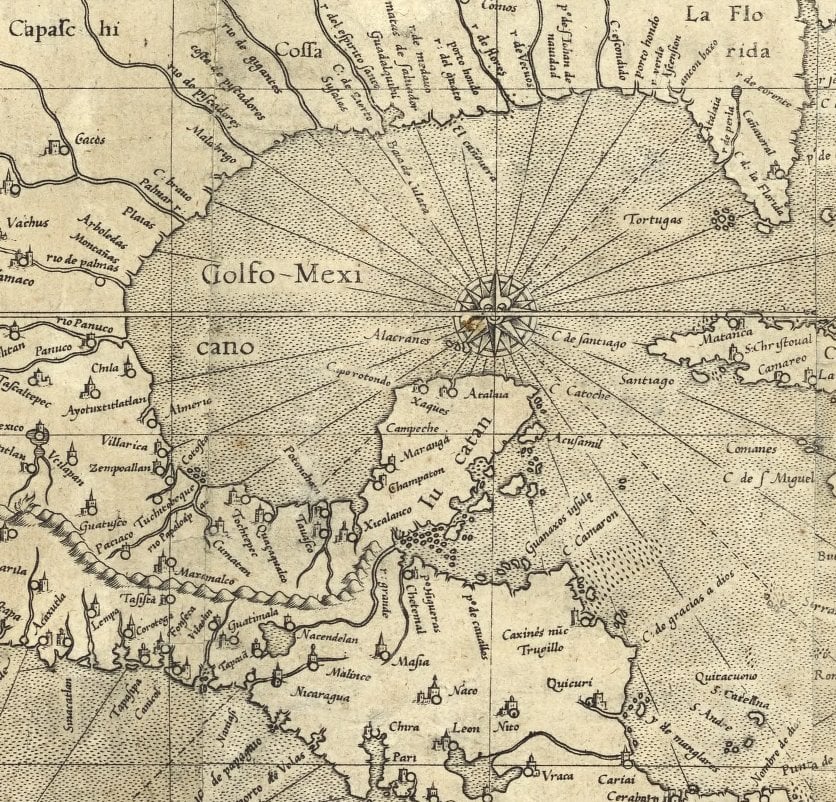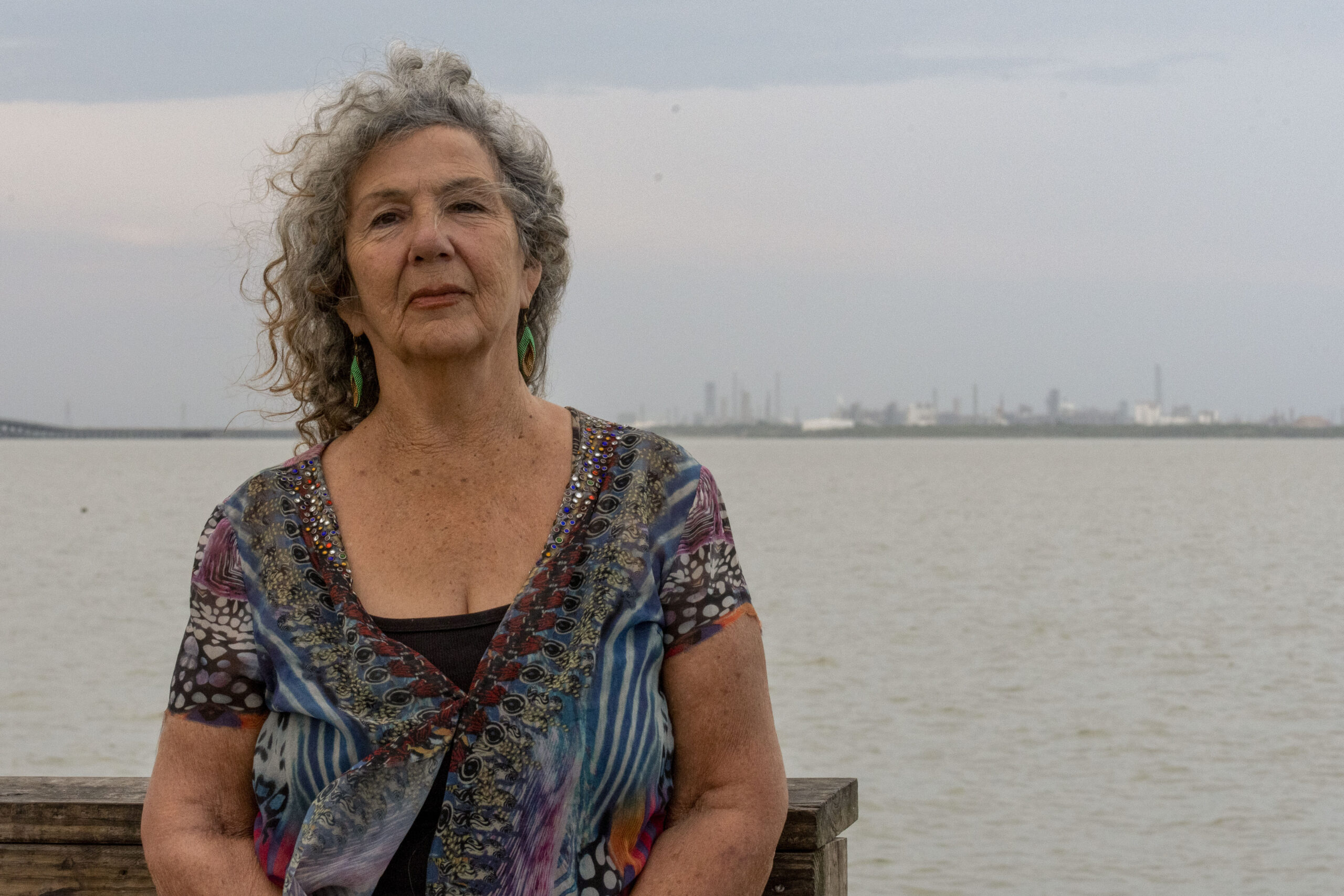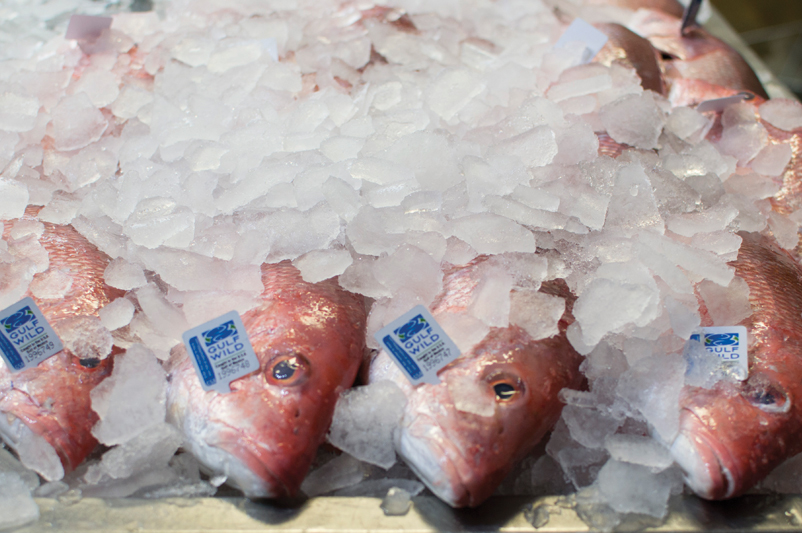
The Gulf’s Red Snapper Fishery Makes a Comeback
A version of this story ran in the September 2014 issue.
The 51-foot Chelsea Ann carves through dark Gulf waters on a brisk March evening. It’s a full day’s journey out to Captain William “Bubba” Cochrane’s fishing spots 70 miles offshore, where the boat’s crew of five will prowl for red snapper. Bubba, 44, and four deckhands left from Katie’s Seafood Market on Galveston’s Pier 19 at noon, and by now the sunlight is all but gone.
Some of the crew is inside the wheelhouse, eating dinner and resting up, but Garrett King is out on the bow preparing for the morning’s early rise. “Just getting ready to do battle,” he says, the lit stub of a cigarette between his lips, shoveling crushed ice into large coolers. King, a doughy man with a soft face and closely shorn hair, has a flair for the dramatic. In his early 30s, he is a part of the next generation of commercial snapper fishermen plying the Gulf of Mexico. He and his fellow crewmembers have a heavy weight on their shoulders—their actions at sea will contribute to the success, or the failure, of the Gulf’s snapper fishery.
In 2012, the commercial catch in the Gulf totaled 1.3 billion pounds inclusive of shrimp, oysters, blue crab and finfish. The dockside price of this catch was $760 million, but between wholesalers, restaurants and processors, the actual value of the industry stretches into the billions of dollars. The Gulf Coast region is the second-leading producer of seafood by volume and value in the United States, and its commercial fisheries support more than 213,000 full- and part-time jobs.
The Northern red snapper, Lutjanus campechanus, is the iconic Gulf fish, and for many commercial fishermen, it’s where the money is. Gulf fishermen harvested 3.6 million pounds of red snapper in 2011, valued at $11.4 million. If all goes according to plan and the fishermen catch 10,000 to 12,000 pounds of red snapper on this four-day trip, Bubba will gross about $50,000. Each crewmember will be paid a couple thousand dollars, depending on how much weight he reels in.
When Garrett’s coolers have enough ice for the next morning’s first haul, he moves on to a wooden workstation beside one of the ship’s six hydraulic “bandits.” A bandit is essentially a fishing reel on steroids: a large spool of thick line threaded over a smaller plastic spool overhanging the water. Garrett will attach his own gear—a series of hooks tied to a long, weighted line—to the bandit, and this bandit will be Garrett’s for the trip. He baits the hooks with mackerel and squid to use in the morning. Farther down the deck, Anthony McComb is doing the same. They’ll have a jump-start on their co-workers the next morning when Bubba wakes the crew before dawn to start the harvest.
More than 20 years have passed since the collapse of the Gulf of Mexico’s red snapper fishery, a nearly 85 percent depletion of the catch between 1965 and 1990 that resulted from decades of overfishing. The National Marine Fishery Services (NMFS) once predicted that the Gulf’s red snapper population wouldn’t rebound fully until 2032. Federally regulated limits, which attempted to both replenish snapper stocks and stabilize the market, backfired tremendously, and by the middle of the last decade, the industry feared a Gulf-wide moratorium on red snapper fishing. But with a new management system in place since 2007, and a growing emphasis on sustainability, both fish and fishermen are now flourishing.
The Gulf’s recovering snapper fishery is an example of a growing effort to undo the effects of half a century of unsustainable fishing, an ongoing disaster that has devastated a number of species. Compared to 1950s stocks, only about 5 percent of bluefin tuna, 10 percent of sharks and 5 percent of Atlantic cod are left. Many local communities that depend on the seafood industry are similarly imperiled.
In Galveston, the man largely responsible for reversing that trend is Buddy Guindon. Guindon spent 30 years as a commercial Gulf fisherman and now owns Katie’s Seafood Market, the only market in Texas associated with the GulfWild sustainable seafood project. These days, at 58, he spends most of his time representing his industry and rallying support instead of fishing. Though Galveston’s commercial snapper fishery is improving today, it remains under constant threat from recreational fishermen, poor federal fishery management, oil spills and hurricanes. Buddy, a patriarch of the community, has taken it upon himself to save his industry.
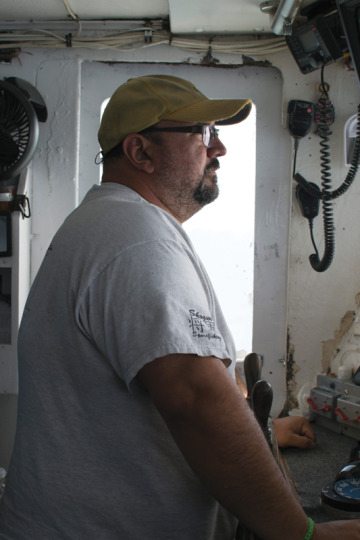
Thirty years of working on a commercial boat has taken a toll on his body. It no longer works the way it used to, back when he was a young boxer in the Marines. Buddy joined as a teenager in the 1970s, just as the country was struggling its way out of Vietnam. “That’s what they teach you to do in the Marine Corps, is fight. Fight with your hands, your feet, your gun,” Buddy says, his coarse voice masking the subtle accent of a native Minnesotan. He was shipped overseas to fight during the Vietnam War and stayed in the Marines until 1977, later making his way to Galveston to work at his father’s Exxon station. He spent his days off fishing, a hobby he’d picked up as a child. “My dad had a car seat screwed to the front of our Lund boat that he put me in when we went out fishing when I was 2,” he remembers. He wears a dark-blue sweatshirt that hides a moderate paunch, and he seems tired. His skin is pockmarked and wrinkled, his face enveloped by a thick white beard. Every now and then he lifts his hat to scratch his head, unveiling a bald scalp surrounded by thin brown hair. The stint at the gas station was short, and he later found work running a bar on the island, still fishing in his off hours. A sign in his bar read, “If you fight, you fight me.” When drunk patrons wanted a fight, he fought them. Buddy relates these stories with a hint of pride and nostalgia. “I couldn’t do that anymore,” he says. “My body can’t take it.”
But Buddy still has a lot of fight in him. Just last year he took the federal government to court, alleging that U.S. Secretary of Commerce Penny Sue Pritzker—via NMFS, the regulatory body in charge of the nation’s fisheries—broke the law with her management of the Gulf red snapper fishery. (“You fight with your brain now. With your brain and your attorney,” he jokes.) In the suit, filed June 28, 2013, Buddy (whose birth name is Keith) led 20 other plaintiffs against what they saw as an overreaching and unsustainable recreational fishing industry that was poorly controlled and, in effect, encouraged by NMFS. Recreational fishermen took 2 million pounds of snapper more than their quota allowed in 2012, but the Gulf of Mexico Fishery Management Council (an extension of NMFS) opened the fishing season the following fall without enacting any reforms. The federal government is required by law to manage its fisheries sustainably; Buddy’s suit contended that wasn’t happening.
In March, a U.S. district court ruled in Buddy’s favor. The decision cited 10 years of growth in recreational fishing harvests, with little to no attempt by NMFS to set sustainable limits or rein in overfishing. “Administrative discretion is not a license to engage in Einstein’s definition of folly—doing the same thing over and over again and expecting a different result,” Judge Barbara Rothstein wrote in her decision.
According to the World Wildlife Fund, the current global fishing fleet is up to three times larger than what the oceans can sustainably support. As a result, about 30 percent of global fisheries are considered overexploited, depleted, or recovering from depletion.
When I first sat down with Buddy, he had just returned from a weeklong stay in Washington, where he testified against Amendment 28 to the Gulf Council’s Fishery Management Plan, which would reapportion up to one-tenth of the red snapper quota from the commercial to the recreational sector. The total allowable catch (TAC) for red snapper in the Gulf, a yearly quota approved by the Gulf Council, is currently set at 51 percent to 49 percent between commercial and recreational fishermen. The two sides have a complex and contentious relationship. “We’ve got a recreational fishery that has problems,” Buddy says, explaining the dispute. “They’ve overfished their quota for the last seven years by at least 50 percent. Last year it’ll be 100 percent.” We were sitting at his desk as he dealt with invoices, phone calls and frequent stop-ins by employees and friends. The office in Katie’s Seafood Market is no bigger than a cabin on one of Buddy’s boats, and fitting more than a few people inside is a challenge. Scattered around the desks were jars of lighted scented candles—a futile attempt to block the overpowering smell of fish from the market below.
Katie’s is an unimposing, corrugated aluminum-clad shack on the pier. The walls are covered with kitschy fishing decor, rows of plastic fish mounts punctuated with an occasional wooden ship’s wheel. At the center of the market is a large, L-shaped display of fish and shrimp. Snapper, grouper, flounder, tilapia, salmon and sometimes tuna or chunks of swordfish are lifelessly tessellated and stacked on ice. The tilapia and salmon aren’t caught in the Gulf; they have to be imported, but you can’t run a fish market without them.
Red snapper is Buddy’s best-seller. Katie’s sells millions of pounds of the fish to giant retailers and distributors like Texas’ H-E-B and Louisiana Foods (owned by Sysco), plus the few dozen fish Buddy keeps in stock, unloaded right off the boats outside, for walk-in customers. Each is tagged with a small white label, a GulfWild marker, that has an identification code traceable to the boat on which it was caught and the area of the Gulf where it was taken. The program launched in 2010, partially in response to BP’s Deepwater Horizon spill. As national media broadcast live footage of thick sludge flowing into the Gulf of Mexico—4.9 million barrels in the three months it took to cap the well—Buddy remembers getting phone call after phone call: “With the oil spill, people were calling and asking, ‘Do you have oil on your shrimp and your fish?’ Well, if I can identify where my fish came from, they can look and say, ‘Well there’s no oil there.’”
But a small group of Gulf fishermen was growing concerned with issues of quality and sustainability even before the spill. The GulfWild program grew out of a 2008 initiative by the Gulf of Mexico Reef Fish Shareholders’ Alliance, a trade organization. “They wanted to create some type of eco-certification. That’s what they were calling it at that time,” says T.J. Tate, sustainability director for GulfWild. “They didn’t really know what that meant, except that they wanted to set themselves apart by being better stewards of the resource.”
GulfWild proponents first reached out to Gulf-state restaurant associations. The food industry’s biggest concern, it turned out, was seafood fraud: misrepresentation and mislabeling of cheaper or imported fish as American red snapper out of the Gulf of Mexico. Falsified labels often came with inflated price tags. Oceana, the world’s largest international ocean conservation and advocacy group, published a study last year reporting that one-third of the 1,215 tissue samples (from 674 retailers in 21 states) it tested were mislabeled. Red snapper was the biggest offender; 87 percent of samples were incorrect. The best solution, the Shareholders’ Alliance thought, was tagging each fish. “Back in 2009 it was a blip on the radar. No one was talking traceability,” Tate says.
The oil spill forced the tracking concept—and an embryonic GulfWild—into play. The GulfWild program soon after came to encompass the four “pillars” of safety, sustainability, traceability and branding. The pillars are designed to support a revitalized Gulf fishery. Fishermen are motivated to participate through access to an easily marketable brand.
Today, 42 boats are partnered with GulfWild, and together they account for roughly 35 percent of the Gulf-wide red snapper quota, and 32 percent of the grouper quota.
“All of our fishermen had to sign conservation covenants to become members of the GulfWild Program,” Tate says, “and the conservation covenants basically say that we are going to hold them responsible to a higher standard of sustainability and accountability.” Some GulfWild boats are outfitted with video systems to track catches and some routinely host observers, and all have significant obligations to minimize bycatch and discards: fish that are either too small, too large or too unprofitable to keep, and so get thrown overboard.
“Whatever fish comes over the rail, they have to keep it,” Tate says. “Then our job, as a GulfWild brand, is to make sure there’s a market for that fish.”
And more market for more fish means more money for fishermen.
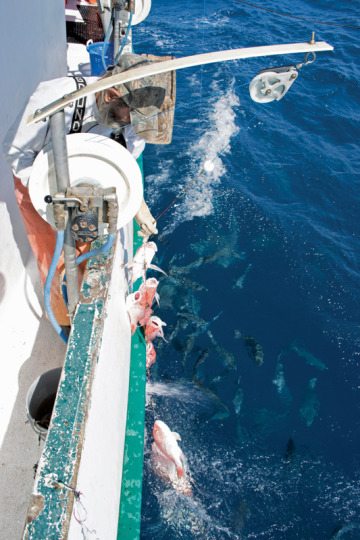
fish in a single day. Alex Dropkin
Out in the Gulf it is 6 a.m.—only orange lights on neighboring oil rigs shine in the darkness. Bubba switches on the Chelsea Ann’s floodlights, and with a thunk the boat’s bow is illuminated in a bright white glow. The light startles the fishermen awake, and they shuffle out of their bunks to prepare for a day of fishing, brewing coffee and heading outside to prep their hooks. Deckhands Chuck Mercer and Troy Noska are out first. By sunrise the fishermen have donned rubber boots and waders and are ready to drop their lines. They start this morning tied up to a natural-gas well, a branching, rusting structure. There are more than 4,000 oil rigs in the Gulf, and the extensive metal scaffoldings below them are hotspots for red snapper. When Bubba gives the word, the men begin.
Bandit fishing resembles a rhythmic dance. Once their gear is attached to their bandits, the fishermen open their reels and toss weighted bars overboard to carry their lines down. The depth of Bubba’s fishing spots varies from 26 to 32 fathoms, and the men fish the entire water column. After a few minutes, the hydraulic system pulls the lines up from the depths strung with bouquets of shimmering snapper. Anthony, a soft-spoken Matthew McConaughey look-alike with a golden mustache and curly hair covered by a tattered military cap, is quick. When his line comes up, he wraps part of it around the bandit, slips another length of the line behind a hook hanging from the ceiling, and pulls his fish into the boat. There is no fight. Most of the fish appear to have given up, gills barely pumping, mouths agape. Aside from their dorsal spines—which can pierce thick rubber—and the sharp teeth from which the species gets its common name, the snapper are now harmless.
“You ever eat a snapper tongue?” I ask Garrett one afternoon.
“No, I don’t think so. They don’t really have tongues,” he says dismissively.
“Then what’s that thing coming out of their mouths?”
When snapper are landed, many have pink bulbs protruding from their mouths. I’d just assumed the bulbs were tongues.
“Their stomachs. They get the bends, like divers. The decompression blows their stomachs out through their mouths,” Garrett says.
While Anthony readies another line on his bandit, the snapper lay motionless on the floor of the boat, waiting to be relieved of their hooks. Once the new line drops, he unhooks his fish and throws them into a bucket to be carried to his cooler.
Some of his snapper are monstrous. Many fish, unlike humans and other mammals, don’t stop growing once they reach a certain age. Gulf snapper can weigh well over 30 pounds, though the most valuable fish weigh between 2 and 4 pounds. Snapper under 13 inches must be thrown back. The remaining fish are packed on ice. Bait, cast, land, unhook, repeat. Anthony does this with one cigarette in his mouth and another behind his ear. He and Chuck, the oldest man on the boat (he’s in his 60s, but no one knows exactly) and the best fisherman, each run two bandits, juggling the rigs.
The men will fish until their coolers are full, which takes less than an hour. It is mostly a silent job—Bubba will speak up when he sees something he doesn’t like, but the fishermen don’t talk much. Troy, 24, is the youngest and least experienced of the fishermen, and he leaves his snapper hanging too long; the wind dries the fish, ruining the flesh.
“That really pisses me off,” Bubba mutters. “Troy needs to learn how to fish.”
Now that GulfWild tags can trace fish to individual boats, quality control has become hugely important. Bad fish can be pinned directly on a captain and translate into lost business.
As the fishermen fill their coolers, Bubba cooks a late breakfast for the crew. Bubba is responsible for breakfast, dinner and a light lunch, and between meals the fishermen survive on processed snack cakes, chips and cigarettes. Breakfast is the only real break of the day. The fishermen file into the wheelhouse like zombies, carrying with them the smell of the ocean and the fish they were wrist-deep in minutes before. The odor coats the walls and floor and ceiling of the cabin.
After eating, the men gut, weigh and pack their fish in the massive ice hold. They figure almost 80 percent of their time is spent gutting, baiting and icing. Each is confined to his own portion of the bow, surrounded by buckets full of fish. The fishermen slice into the snapper with long boning knives, slipping gloved hands into the carcasses and extracting livers, intestines, stomachs and kidneys.
The men have caught 2,000 pounds of snapper in the first round of fishing, with Anthony in the lead. This afternoon they’ll catch another 3,000 pounds.
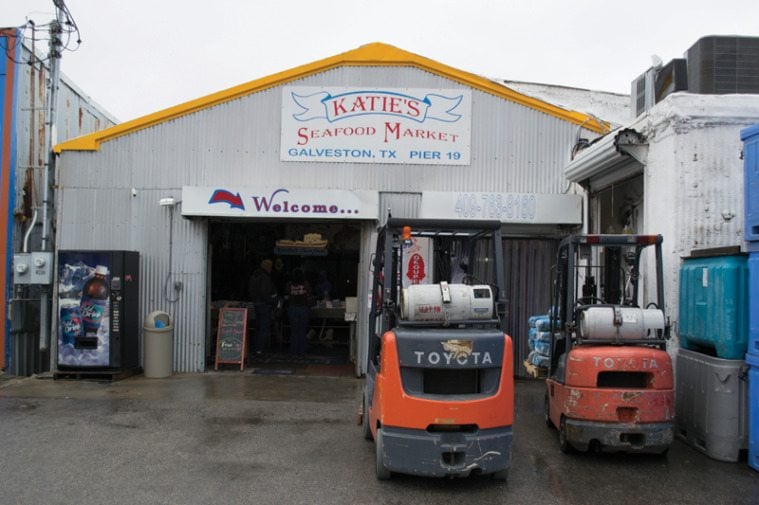
In a last-ditch effort to reboot the snapper fishery seven years ago, the Gulf Council approved an “individual fishing quota” (IFQ) system. Under the terms of a previous attempt to curb overharvesting, commercial Gulf fishermen were restricted to fishing the first 10 days of the month, in a limited number of months each year, and could catch no more than 2,000 pounds per trip, with no more than one trip every 24 hours.
The Gulf Coast region is the second-leading producer of seafood in the United States, and its commercial fisheries support more than 213,000 full- and part-time jobs.
“Back then our prices were really low when we fished, and then the imports would shoot up as soon as our season was over because they could control their supply,” Buddy says. “They’d have every week, and we only had the first 10 days of the month, so we were getting killed.” Gulf fishermen refer to this period as the “derby,” which existed in one form or another from 1992 to 2006, and they suffered through it. Now each Gulf snapper fisherman with a permit owns the right to harvest a percentage of the total commercial quota. Captains can fish at their own pace, year-round, and because the market isn’t flooded with American red snapper all at the same times, prices are much more consistent. According to Buddy, the IFQ system has increased the price each boat gets for its fish almost twofold, reduced expenses by 70 to 80 percent, and reduced discards by more than 80 percent. At the same time, the snapper fishery has more than doubled. “It’s getting better and better every year, because now they have incentivized us as fishermen to take care of our fishery rather than exploit it like we used to do,” Buddy says.
By the time the Gulf Council considered switching to a new system, commercial fishermen could barely meet their quotas due to the unsustainable practices encouraged by the derby. Fishermen kept only ideal-size snapper; everything else was thrown back, and most of those fish died. In extreme cases, Bubba told me, fishermen would kill 500 pounds of snapper just to keep 200 pounds. Discarding for value was routine, and fishermen stayed close to shore because they had no time to venture farther out to more plentiful reefs. “Catching more and making less used to be the way we drove the ball down the road,” Buddy says.
Like many captains, Bubba was skeptical of the IFQ system when it was first proposed. When he received his ballot in the mail to vote on the measure, he gave it no thought. The derby system wasn’t great, but he reasoned that the devil you know is better than the devil you don’t. Then, just before switching systems, the Gulf Council slashed the snapper quota in half. After the switch, they slashed it in half again. Fears that the fishery would close were rampant. Bubba did the unthinkable and bought some of the diminished quota for himself. “I just wanted to go fishing,” he says. Ever since the federal government put a moratorium on Gulf fishing permits in 1992, captains have been buying and selling the right to harvest snapper. To get in, Bubba had to buy someone else’s share. The captain from whom Bubba bought the majority of his quota had rights to roughly 50,000 pounds per year. In 2007, the price to buy in was $10 a pound. To pay for his quota, Bubba not only had to refinance his house, but also his father’s house and another property they owned together. His father thought Bubba was crazy, and though he trusted his son, he didn’t trust the system. Red snapper quota now sells for $40 a pound, and Bubba owns about 3 percent of the total allowable commercial catch, or close to 130,000 pounds. “It ended up being the best fucking thing that ever could’ve happened,” he says of his gamble.
The same year that Gulf fishermen were debating the switch to a new system, Boris Worm made international headlines. Worm is a biologist at Dalhousie University in Halifax, Nova Scotia, and runs a marine conservation lab. He and his students announced in a 2006 paper that if overfishing trends continued at current rates, there would be no viable fish stocks left in any ocean by 2048. Despite the installment of better management systems in developed countries, the outlook remains grim. According to the World Wildlife Fund, the current global fishing fleet is up to three times larger than what the oceans can sustainably support. As a result, about 30 percent of global fisheries are considered overexploited, depleted, or recovering from depletion. Only 1 percent of the U.N. Food and Agriculture Organization’s 600 monitored fisheries are considered “recovering.” The Gulf red snapper fishery, described by the NMFS in 2011 as overfished, is a microcosm of the global issue.
Organized commercial snapper fishing began in Galveston in the late 1800s, as a fleet of boats began harvesting the fish right off the coast of Texas. The fleet introduced fishing in greater numbers and efficiencies unmatched by individual fishing boats, owners or operators. From there, harvesting and yields rose steadily, and finally peaked in 1964. With the help of radar and sonar technology developed in World War II and improvements to fishing gear, Texas snapper fishermen hauled in 2.25 million pounds that year. The snapper population couldn’t sustain such rampant depletion, and in 1979 the same fishery yielded barely more than 200,000 pounds of red snapper.
“There are still those fishermen out there who are never going to change,” GulfWild’s Tate says. “They don’t give a damn about sustainability.”
The biggest hurdle in creating sustainable fishery-management systems, Worm pointed out, is that fisheries have traditionally been open-access, belonging to everyone and, at the same time, no one—a dynamic known as the tragedy of the commons. Such open access provides “an incentive to take the last fish, because if you don’t get it somebody else will,” Worm tells me over the phone. Before snapper yields bottomed out in the Gulf of Mexico, fishermen could take as much as they wanted, whenever they wanted. But under the IFQ system, there’s no longer a need to take every last fish. Fishermen now catch snapper at their own pace, filling their own quotas.
“For me, it’s passing on my business to my family, and it’s important to me that it be a good, sustainable fishery that’s going to be here for generations to come,” Buddy told me. His oldest son, Nick, 31, now runs Katie’s Seafood, and one of Buddy’s other sons was fishing offshore as he and I spoke. But there are plenty of fishermen in the Gulf who aren’t interested in any form of conservation, and some have entertained the notion of returning to a derby system.
“There are still those fishermen out there who are never going to change,” GulfWild’s Tate says. “They don’t give a damn about sustainability.”
In two full days of fishing, plus a few hours in the morning of a third, Bubba’s crew landed 12,100 pounds of red snapper. The fish have already been contracted for, so the only thing they have to worry about is getting the snapper back to shore. Once the fishing is finished, and Bubba fires up the engines to return to Galveston, the men are eager to find out how they did. Chuck caught the most: 3,250 pounds of snapper. Garrett, trying out a different type of gear, caught 2,625 pounds. Bubba pays them 70 cents per pound, so Garrett made just over $1,800. He looks at Bubba’s log, dissatisfied. “I got spanked on this trip. I don’t like that feeling,” he says. After compensating his crew, paying a 3 percent tax to the federal government, and accounting for several thousand dollars in fuel and supplies, Bubba will walk away from this trip with about $40,000.
On the long haul back to shore, the crew cleans the Chelsea Ann. They wash their gear, waders and boots, and scrub off the salt and blood and fish residue that has built up on every surface of the boat. By late afternoon, the only thing left to do is sleep. Under the IFQ system, Bubba must notify the federal government at least three but no more than 12 hours before his return through a vessel monitoring system. He had to do this leaving port, as well. Failure to do so—even getting to the docks early—could cost him. But Bubba times his return perfectly, and the boat snugs up the pier at 10:30 p.m. By regulation, fish can be unloaded only between 6 a.m. and 6 p.m., so Bubba and his crew will be back the next morning to finish the job. They’ll put a GulfWild tag on each fish, leaving their mark on snapper to be shipped across Texas, the Gulf Coast, and the country.
To support journalism like this, donate to the Texas Observer.